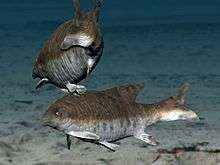Scheenstia
| Scheenstia Temporal range: Late Jurassic–Early Cretaceous, 150–125 Ma | |
|---|---|
| | |
| Fossil specimen of S. maximus | |
| Scientific classification | |
| Kingdom: | Animalia |
| Phylum: | Chordata |
| Class: | Actinopterygii |
| Order: | †Semionotiformes |
| Family: | †Semionotidae |
| Genus: | †Scheenstia López-Arbarello & Sferco, 2011 |
| Type species | |
| Scheenstia zappi López-Arbarello & Sferco, 2011 | |
| Species[1] | |
|
†S. mantelli (Agassiz, 1833) | |
Scheenstia is an extinct genus of neopterygian ray-finned fish from the Cretaceous period. Fossils have been found in Bavaria, France, and England.

Scheenstia is frequently pictured as the prey of the large dinosaur Baryonyx walkeri because the scales and teeth of these fish were found in the stomach region of a fossil B. walkeri specimen. The fish remains were previously referred to the related genus Lepidotes, but all Cretaceous species of that genus have since been re-classified as Scheenstia following detailed phylogenetic analysis.[1]
Classification
Scheenstia is a genus of lepisosteiform that is related to the genus Lepidotes. The latter has been one of the greatest actinopterygian wastebasket taxa, with one 2012 study finding species referrable to a minimum of three different and distantly related genera. Scheenstia is also related to Isanichthys. A cladogram showing the relations of Neopterygii was published in the review, and a simplified version labelling the previous species of Lepidotes is shown here.[1]
| Ginglymodi |
| ||||||||||||||||||||||||||||||||||||||||||||||||||||||||||||||||||||||||||||||||||||||||||
| |
References
- 1 2 3 López-Arbarello, A. (2012). "Phylogenetic Interrelationships of Ginglymodian Fishes (Actinopterygii: Neopterygii).". PLoS ONE. 7 (7): e39370. doi:10.1371/journal.pone.0039370. PMC 3394768
 . PMID 22808031.
. PMID 22808031.